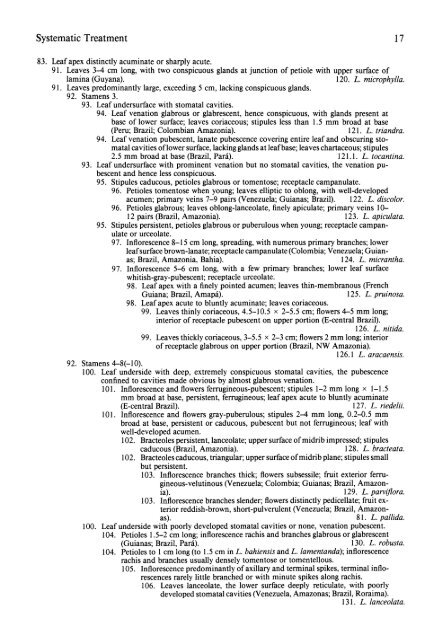flora neotropica - CNCFlora
flora neotropica - CNCFlora
flora neotropica - CNCFlora
You also want an ePaper? Increase the reach of your titles
YUMPU automatically turns print PDFs into web optimized ePapers that Google loves.
Systematic Treatment 17<br />
83. Leaf apex distinctly acuminate or sharply acute.<br />
91. Leaves 3-4 cm long, with two conspicuous glands at junction of petiole with upper surface of<br />
lamina (Guyana).<br />
120. L. microphylla.<br />
91. Leaves predominantly large, exceeding 5 cm, lacking conspicuous glands.<br />
92. Stamens 3.<br />
93. Leaf undersurface with stomatal cavities.<br />
94. Leaf venation glabrous or glabrescent, hence conspicuous, with glands present at<br />
base of lower surface; leaves coriaceous; stipules less than 1.5 mm broad at base<br />
(Peru; Brazil; Colombian Amazonia).<br />
121. L. triandra.<br />
94. Leaf venation pubescent, lanate pubescence covering entire leaf and obscuring stomatal<br />
cavities of lower surface, lacking glands at leaf base; leaves chartaceous; stipules<br />
2.5 mm broad at base (Brazil, Para).<br />
121.1. L. tocantina.<br />
93. Leaf undersurface with prominent venation but no stomatal cavities, the venation pubescent<br />
and hence less conspicuous.<br />
95. Stipules caducous, petioles glabrous or tomentose; receptacle campanulate.<br />
96. Petioles tomentose when young; leaves elliptic to oblong, with well-developed<br />
acumen; primary veins 7-9 pairs (Venezuela; Guianas; Brazil). 122. L. discolor.<br />
96. Petioles glabrous; leaves oblong-lanceolate, finely apiculate; primary veins 10-<br />
12 pairs (Brazil, Amazonia).<br />
123. L. apiculata.<br />
95. Stipules persistent, petioles glabrous or puberulous when young; receptacle campanulate<br />
or urceolate.<br />
97. Inflorescence 8-15 cm long, spreading, with numerous primary branches; lower<br />
leaf surface brown-lanate; receptacle campanulate (Colombia; Venezuela; Guianas;<br />
Brazil, Amazonia, Bahia).<br />
124. L. micrantha.<br />
97. Inflorescence 5-6 cm long, with a few primary branches; lower leaf surface<br />
whitish-gray-pubescent; receptacle urceolate.<br />
98. Leaf apex with a finely pointed acumen; leaves thin-membranous (French<br />
Guiana; Brazil, Amapa).<br />
125. L. pruinosa.<br />
98. Leaf apex acute to bluntly acuminate; leaves coriaceous.<br />
99. Leaves thinly coriaceous, 4.5-10.5 x 2-5.5 cm; flowers 4-5 mm long;<br />
interior of receptacle pubescent on upper portion (E-central Brazil).<br />
126. L. nitida.<br />
99. Leaves thickly coriaceous, 3-5.5 x 2-3 cm; flowers 2 mm long; interior<br />
of receptacle glabrous on upper portion (Brazil, NW Amazonia).<br />
126.1 L. aracaensis.<br />
92. Stamens 4-8(-10).<br />
100. Leaf underside with deep, extremely conspicuous stomatal cavities, the pubescence<br />
confined to cavities made obvious by almost glabrous venation.<br />
101. Inflorescence and flowers ferrugineous-pubescent; stipules 1-2 mm long x 1-1.5<br />
mm broad at base, persistent, ferrugineous; leaf apex acute to bluntly acuminate<br />
(E-central Brazil).<br />
127. L. riedelii.<br />
101. Inflorescence and flowers gray-puberulous; stipules 2-4 mm long, 0.2-0.5 mm<br />
broad at base, persistent or caducous, pubescent but not ferrugineous; leaf with<br />
well-developed acumen.<br />
102. Bracteoles persistent, lanceolate; upper surface of midrib impressed; stipules<br />
caducous (Brazil, Amazonia).<br />
128. L. bracteata.<br />
102. Bracteoles caducous, triangular; upper surface of midrib plane; stipules small<br />
but persistent.<br />
103. Inflorescence branches thick; flowers subsessile; fruit exterior ferrugineous-velutinous<br />
(Venezuela; Colombia; Guianas; Brazil, Amazonia).<br />
129. L. parvi<strong>flora</strong>.<br />
103. Inflorescence branches slender; flowers distinctly pedicellate; fruit exterior<br />
reddish-brown, short-pulverulent (Venezuela; Brazil, Amazonas).<br />
81. L. pallida.<br />
100. Leaf underside with poorly developed stomatal cavities or none, venation pubescent.<br />
104. Petioles 1.5-2 cm long; inflorescence rachis and branches glabrous or glabrescent<br />
(Guianas; Brazil, Para).<br />
130. L. robusta.<br />
104. Petioles to 1 cm long (to 1.5 cm in L. bahiensis and L. lamentanda); inflorescence<br />
rachis and branches usually densely tomentose or tomentellous.<br />
105. Inflorescence predominantly of axillary and terminal spikes, terminal inflorescences<br />
rarely little branched or with minute spikes along rachis.<br />
106. Leaves lanceolate, the lower surface deeply reticulate, with poorly<br />
developed stomatal cavities (Venezuela, Amazonas; Brazil, Roraima).<br />
131. L. lanceolata.

















